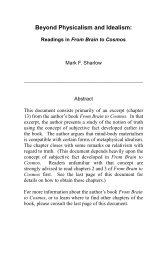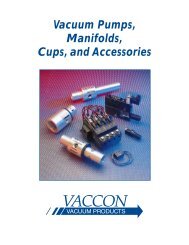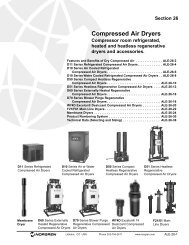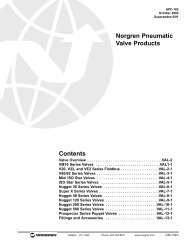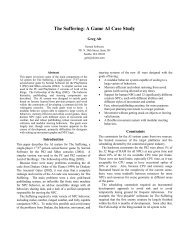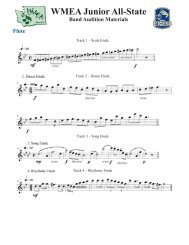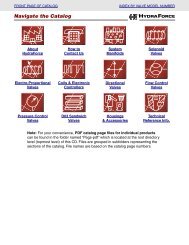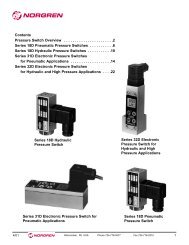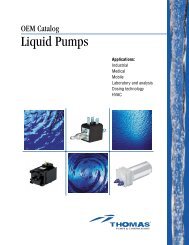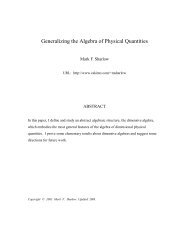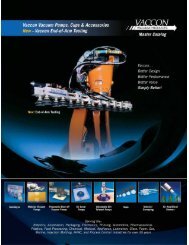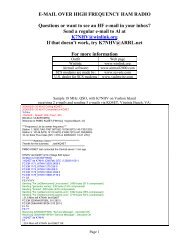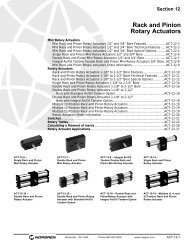Navigate the Catalog HYDRAFORCE
Navigate the Catalog HYDRAFORCE
Navigate the Catalog HYDRAFORCE
- No tags were found...
You also want an ePaper? Increase the reach of your titles
YUMPU automatically turns print PDFs into web optimized ePapers that Google loves.
®<br />
<strong>HYDRAFORCE</strong><br />
Intro. to Electro-Hydraulic Control Technology<br />
ELECTRO-HYDRAULIC CONTROL<br />
Electronic Control<br />
Electronic control in mobile equipment can consist of <strong>the</strong><br />
following:<br />
Inputs: Inputs can be defined as <strong>the</strong> user interface, and can<br />
consist of joysticks, potentiometers, an operator panel, or o<strong>the</strong>r<br />
input device.<br />
Controller or PLC: This is <strong>the</strong> brains of <strong>the</strong> electronic control.<br />
It processes <strong>the</strong> inputs and converts <strong>the</strong>m into a defined output<br />
to <strong>the</strong> hydraulic system. The controller also can have <strong>the</strong> ability<br />
to receive feedback inputs from machine sensors and attenuate<br />
its outputs accordingly. The controller can be factoryprogrammed<br />
or have <strong>the</strong> ability to be user programmable to<br />
meet <strong>the</strong> specific needs of <strong>the</strong> application.<br />
Outputs: Outputs can be on/off voltage signals or proportional<br />
PWM signals to control <strong>the</strong> hydraulic valving.<br />
Communications: The controller can have <strong>the</strong> ability to<br />
engage in two-way communications with a bus system.<br />
Feedback Inputs: Can consist of pressure transducers,<br />
temperature sensors, flow sensors, velocity sensors or RPM<br />
sensors. When feedbacks are used <strong>the</strong> system is described as<br />
“closed loop.”<br />
Digital<br />
Digital signals vary in discrete steps or increments. A digital<br />
signal is normally in <strong>the</strong> form of a series of pulses that rapidly<br />
change from one distinct, fixed voltage level to ano<strong>the</strong>r.<br />
A clock that displays <strong>the</strong> time in actual numerals that change in<br />
one-numeral increments is an example of a digital device.<br />
Accuracy in a digital device is generally higher than in an<br />
analog device. In digital systems, physical variables are<br />
represented by numerical values using <strong>the</strong> binary (base 2)<br />
number system.<br />
Electronic Control Platforms<br />
Some of <strong>the</strong> different forms that mobile electronics can take<br />
are described in <strong>the</strong> chart below. There is an increasing<br />
complexity and cost as <strong>the</strong> controllers move from singlefunction<br />
analog controls to complete complex digital control<br />
systems.<br />
Digital vehicle controllers offer a high level of sophistication by<br />
executing a programmed sequence of functions that constantly<br />
control all motion parameters.<br />
PLC—Programmable Logic Controller<br />
PLC’s were developed to replace <strong>the</strong> older “sequential relay<br />
circuits,” that were used for machine control. The PLC works<br />
by measuring its inputs and depending on <strong>the</strong>ir state, switching<br />
its outputs on or off. The user enters setup instructions, usually<br />
via software, that will produce <strong>the</strong> desired results. Because<br />
many of <strong>the</strong> controller’s functions are user programmable, a<br />
PLC has <strong>the</strong> versatility to be field-modified for changing<br />
applications or conditions.<br />
Some PLC’s have <strong>the</strong> capability to convert analog inputs,<br />
process <strong>the</strong>m digitally, and produce analog outputs. PLC’s that<br />
do not have built-in converters require separate analog-todigital<br />
converters to convert <strong>the</strong> input.<br />
Analog<br />
An analog signal is an AC or DC voltage or current that varies<br />
smoothly and continuously. In an analog system, a physical<br />
variable is represented by a proportional voltage that varies in<br />
correspondence with <strong>the</strong> physical variable. Electronic circuits<br />
that process analog signals are called linear circuits.<br />
An example of an analog device is a traditional-style clock that<br />
has hour and minute sweep hands that rotate around <strong>the</strong> dial.<br />
It is very difficult to get a highly accurate time reading with this<br />
type of clock. The precision of <strong>the</strong> dial calibration is a limiting<br />
factor.<br />
Increasing Complexity and Value<br />
Electronic Control Technology Platforms<br />
for <strong>the</strong> Mobile Equipment Market<br />
Vehicle Control Systems<br />
Vehicle Control Subsystems<br />
Transmission Controller<br />
Digital Control Products<br />
Microprocessor<br />
PID Controller<br />
Motor Controller<br />
Closed Loop<br />
Flow Controller<br />
Fan Drive<br />
(with Sensor Input)<br />
On/Off<br />
Functions<br />
Digital Signal<br />
Processor (DSP)<br />
Pump Controller<br />
Analog Control Products<br />
Proportional<br />
Valve Controllers<br />
Soft Shift<br />
Soft Shift/Hold<br />
Low Cost Fan Drive<br />
Converter<br />
Controller<br />
with Position<br />
Feedback<br />
(Servo<br />
Mechanism)<br />
3.500.1



